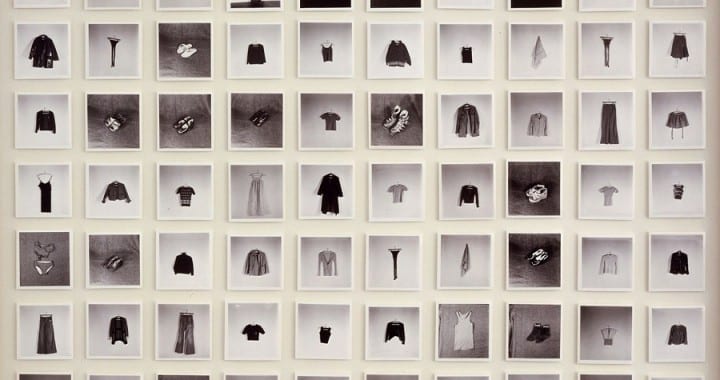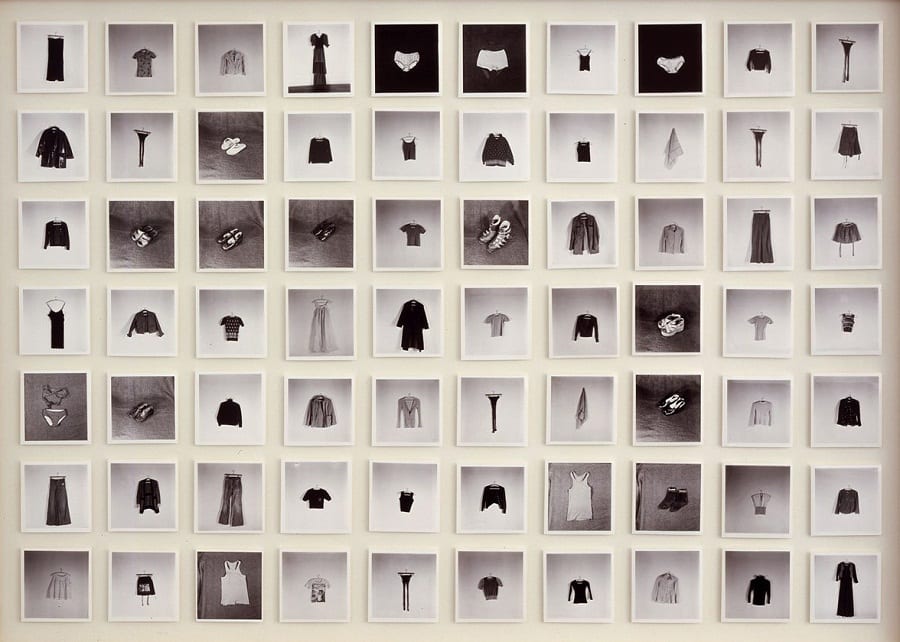
All the Clothes of a Woman, 1970’s
By Roy Arden, This curator’s text was originally published for the exhibition ‘Hans-Peter Feldmann’ at the Contemporary Art Gallery, Vancouver, June 9 – August 20, 2006.
Hans-Peter Feldmann’s oeuvre includes works in many media, from painting to sculpture, installation, photography, collage, bookworks, archives or collections of images, objects, etc, however it is his photographic works and his largely photographic books for which he is most known and on which I will concentrate most of my attention here. Where Feldmann does not use found vernacular images he often makes his own. These range stylistically from the casual snapshot, as in his series of pictures from windows of hotel rooms, to the refined, even masterful photograph, as in his portrait project 100 Jahre (100Years).
I first saw Feldmann’s work in the late 1970s in the seminal book of photographic art theory by Volker Kahmen entitled The Art History of Photography. Kahmen’s book was the first to take an verview of photographic art from its very beginnings up to the post-conceptual period and offer a viable aesthetic theory of art as photography. Feldmann was represented by several grids of photographic images derived from his early Bilder Hefte (Picture Booklets) of the 1970’s, a series of cheaply printed booklets that then sold for a few dollars in German art book stores.
A typical Picture Booklet would have a title such as 11 Bilder stamped on its cardboard cover and, in tautological form, would contain only eleven black and white reproductions, one per page, of women’s knees. Other Picture Booklets would show pictures of equally banal images such as unmade beds, professional footballers or snow-capped mountain peaks.
The Picture Booklets are European cousins to Ed Ruscha’s famous bookworks. Like Ruscha, Feldmann was a member of the conceptual art generation that sought to perform a radical interrogation and critique of every aspect of traditional notions of art. Unlike an artist such as Ruscha, Feldmann’s work has often taken an overtly political position, sometimes leaving the arena of art for interventions in the larger world. Feldmann’s work has never shied away from moral issues, and his morality has always been grounded in a historical understanding, so it is important to understand both him and his work in specifically historical terms and context.
Feldmann was born in 1941 in Hilden, a small town near Düsseldorf. He is known in Europe as a major figure of the Düsseldorf art scene, whose most famous members were, or are; Gerhard Richter, Bernd & Hilla Becher, Sigmar Polke, Blinky Palermo and Joseph Beuys. That Feldmann is less well known in North America is due probably to his lack of careerist motivation and the intrinsic nature of his work, which tends towards the understated gesture and away from the unique, more marketable, hand-wrought forms like painting and sculpture. Yet as a seminal figure in conceptual art’s interrogation of tradition, his early photographic works, characterized by direct appropriation of vernacular photography, have paved the way for such important North American artists as Richard Prince, Sherrie Levine, Christopher Williams, and many more.
In the 1950s and ‘60s, Düsseldorf was home, or played host to, various artists associated with art informel, the Nouveau Realistes, and Group Zero, including Yves Klein, Piero Manzoni, Jean Tinguely, Daniel Spoerri, Gunther Uecker, Heinz Mack, and others. Joseph Beuys began teaching in Düsseldorf in the early ‘60s and was largely responsible for the liveliness of the scene for the next two decades. It was in the 1970s that the Düsseldorf scene took form: in this decade it would not be unusual to find Richter, Polke, Palermo, Beuys, Marcel Broodthaers, the Bechers, electro-pop pioneers Kraftwerk, and Feldmann all drinking and chatting in the Uel bar on Ratingerstrasse. Düsseldorf is a rather small and unremarkable city: why it came to be the centre of art production in Germany is an area of investigation that deserves its own essay.
Feldmann, perhaps more than any other artist from Düsseldorf, reflects the humble nature of the place. Although he has moved many times in his life, it has usually been within a few blocks of his previous residence, always in the centre of town. Feldmann has supported himself largely from his extra-artistic activities: he has owned small shops selling toys, knick-knacks and especially thimbles; and with his brother-in law, he has made a business of manufacturing replicas of vintage pressed tin toys. In the 1980s he retired from the artworld altogether in dissatisfaction with the direction it was taking as the artmarket exploded and a new conservatism replaced the politicised bohemianism of the 1970s. Later, when he returned to exhibiting in the 1990s, he would say that he was wrong to show his dissatisfaction, and that he should have instead just tried himself to do things differently.
Beuys, the elder figure of the Düsseldorf arts scene, and an ex-Luftwaffe airman, mythologised the war and his own involvement. His changing stories and “shamanistic” mysticism read like denial: he seemed unwilling or unable to come to terms with that dark period in concrete historical terms. Richter, Polke and Feldmann’s generation were also marked by the war, but they were too young to be involved in it as anything other than innocent victims. Pop Art appealed to these artists as a critique of American capitalist culture and the Wirtschaftswunder or Economic Miracle of Germany’s post war rise as a democratic capitalist state. They successfully fashioned a specifically German variant of Pop Art that was more critical, or less ambivalent, than their American counterparts. Feldmann’s early works used humour and scale along the lines of Claes Oldenburg to produce oversized paintings and sculptures of everyday objects. However, he soon abandoned this work for his later interest in collecting, ordering and presenting archives of mostly photographic imagery. The notion of “Capitalist Realism” famously put forward in an exhibition by Richter, Polke and Konrad Lueg, demonstrated the acutely politicised climate of German art in this period, which was still living with the recent memory of National Socialist Realism as well as the ongoing Socialist Realism of the East Bloc. Like the art of many of his peers, Feldmann’s work has been informed and even driven by a need to understand the German past and affect its future.
In 1975 Feldmann sent envelopes, each containing a letter and twelve snapshots, to people with whom he was personally acquainted in the local art scene. The amateur-porn style, flash photos showed the artist engaged in a ménage à trois with two women in a deep-red brothel-like setting. The letter tells that while he wasn’t ashamed to perform such acts in private, their public display was another matter. Yet, he explains, there are much more shameful, “really sickening” things, being done in public, for which the majority feel no shame. This untitled work was intended to contrast the prevailing contradictory morals regarding sex and violence.
At the time, Feldmann was disgusted by both the continued presence of old Nazis in German politics, as well as American imperialism. He reasoned that sex was nothing to be ashamed of, yet its depiction was still largely censored, whilst generals with the blood of innocents on their hands were free, and often proud, to participate in public life. Here, Feldmann joined in the political and moral protests of that time in the most personal way, he literally exposes himself as a vulnerable human being and grounds his moral judgment, his accusation, in his existential humanity, rather than any external religious or philosophical belief. While he uses photographs as documents, the work is a kind of performance, a trial. Although, like the Viennese Aktionismus artists, Valie Export or Chris Burden, this trial would seem to centre on the artist as a naked participant in a physical act, the trial here is not really the initial act depicted in the photos but rather the secondary result of the photos: the trial of potential shame he would experience in the community as the photographs were seen and circulated.
Many of Feldmann’s works focus on the individual’s relation to society. A 1994 bookwork entitled Porträt (Portrait) is an abridged version of the personal photo album of a close friend. Consisting predominantly of amateur snaps, it shows a woman’s life as she grows up before the backdrop of history. We see her on the first day of school, with boyfriends, as a hair model, on vacation in Paris etc. The quality of the snapshots is surprisingly good, rich with historical detail. We see the evolution of styles and the increased informality of private life over the years. As we are drawn into the narrative, we see that these pictures are also an index of Germany’s postwar climb from disaster to the Economic Miracle and beyond. What might at first appear as a souvenir, valuable only to its owner and her family, is revealed as a historic document of public significance.
In All the Clothes of a Woman, a piece from the 1970s, we see exactly what the title promises, dozens of square photos, each documenting one article of his friend’s wardrobe. Worn clothes, like photographic portraits, are indexical traces of a person. This work doubles-up the haunted aspects of both clothes and photographs. The association to images of piles of clothes at Auschwitz is unavoidable, as is the association of baby shoes kept as souvenirs or fragments of clothes purportedly belonging to saints. We imbue such objects with a magic, the magic of a presence in absence that is also at the centre of photography’s power.
In Birgit (2006), the artist has made colour snapshots of a friend applying her make-up from beginning to end. In correspondence to me Feldmann said of this work “…of course you can see how she gets prettier with each picture”. Again Feldmann is concerned about the relation of the individual to society. In spite of clichés about people wanting to “look good for themselves,” it is clear that without others around we wouldn’t even have a concept of “looking good.” Animals are known to kill others of their species just for looking bad: it is Darwinism in action and people have had to learn to curb this instinct. Ethnic, racial, class, and other hatreds often hinge their propaganda on appearance.
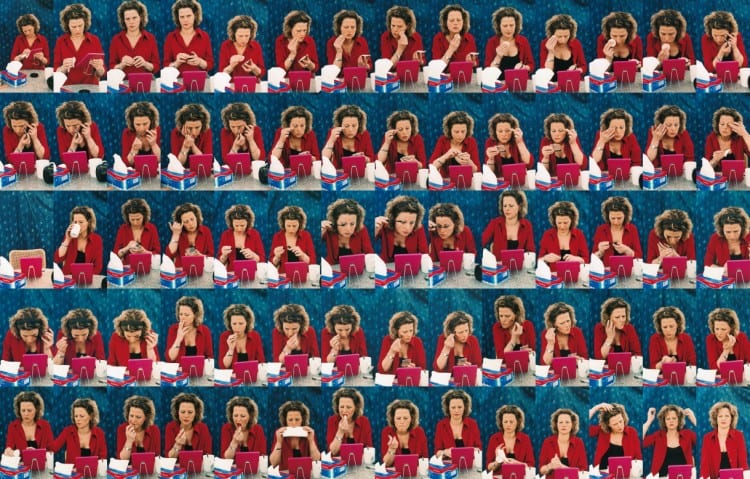
Birgit, 2006
Painting faces is as old as society. In the West, the recent rise in piercing and tattooing is evidence that we no longer define ourselves as civilized by our relative lack of personal ornament. Each culture sees its own customs as natural, if it sees them at all. In its attention to artifice, Birgit is connected to Feldmann’s hand coloured photocopy pictures or his painted plaster miniatures of Greek and Roman statues. These works cause us to question our assumptions about taste and kitsch as cultural and class phenomena. Birgit makes the everyday, the banal, appear strange – one picture of a woman doing her make-up wouldn’t raise questions, but a series of 72 consecutive pictures causes us to think and observe like an anthropologist.
Feldmann’s attention to the individual is always characterized by a tenderness that stops well short of mawkish sentimentality. The fragility and sanctity of the individual is ultimately best examined and presented in Feldmann’s most recent major work, Frauen im Gefangnis (Women in Prison) 2004-05. Presented as both gallery exhibition and book, Women in Prison is the product of a year of visits to the Cologne-Ossendorf “correctional facility”. Feldmann worked closely with Klaus Heilmann, the resident art therapist, collecting testimony from the prisoners and the staff of doctors, guards, clergymen and other officials who administer to them. The book is full of artworks and letters produced by inmates, statistics and meal plans, detailed colour photos of the prison environment, and so on. I have never seen a publication that tells me more about the inside of a prison and the relations between all involved. Most importantly, Feldmann entirely avoids the clichéd images of despair that we have come to expect around this subject.
In his forward, Feldmann cites the well-known fact that most prisoners were victims before they became perpetrators, but he also acknowledges society’s need to be protected from these often very dangerous people. His mission is simply to enlighten: “If this book can contribute to making the prisoners’ situation a bit clearer, then the work of all involved was not in vain.” The style of this book is simple and accessible. I am sure that most people who pick it up in a bookstore or library would be surprised to learn that it is an artwork or that it was made by an artist. The recent fashion in the art world towards “socially engaged art” is based on the rejection of the artist as an autonomous, outsider genius, in favour of the productivist model of the cultural worker within society. More often than not, the products of this tendency suffer from a falling between disciplines, producing neither good art nor good social science. With Women in Prison Feldmann has succeeded in creating a paradigm for an art of social conscience and engagement.
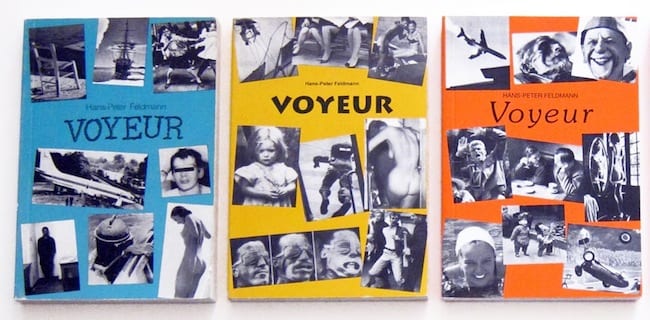
Voyeur series
In his two books entitled Voyeur 1 (1994) and Voyeur 2 (1997), Feldmann makes compact, affordable paperback representations of the image spectacle. Images from every possible vernacular are here, crime photos, fashion photos, sports photos, advertising photos, and so on. Selected from a wide variety of largely twentieth century sources, they are presented scrapbook style in miniaturized black and white half-tone reproductions. There is not much of an ordering system and the images seem to assault us much as they do in everyday life, yet the size reduction and the elimination of colour makes it easier to see and compare these pictures typologically.
If one looks closely, there is one picture that is repeated, an image of a vacant chair by the sea. Presumably, this is an offering from the author to sit down and enjoy the spectacle. That so many of the pictures are ridiculously high-key is readily apparent, they are all screaming for our attention, hoping to push one of our buttons and win a few fractions of a second of our lives. They also serve to conjure up the personal memories that we find attached to public historic moments.
Feldmann’s magazine projects have also dealt with image spectacle. His single issue Image magazine from the ‘70s was printed in black and white on newsprint and was very similar, perhaps a prototype for the Voyeur books. In 2000 Feldmann collaborated with Austria’s Profil magazine, convincing them to print a run of an issue without text. This kind of experiment is more instructive than one might think: the experience of looking at the images without their qualifying captions and articles is uncanny and frightening. At the time, there was a running battle between the media and far-right leader Joerg Haider over freedom of the press. Feldmann managed to time his intervention so that the textless issue of Profil featured a cover image of Haider signing a coalition deal that would have him enter the federal government. Feldmann’s Profil issue is a graphic image of a voiceless press. Austria has a history of political interference in the media and Haider later sued Profil’s editor for libel for various stories including one where Haider quotes were juxtaposed with Hitler quotes.
Feldmann is a connoisseur of the most ephemeral private moments. He has made “Pictures of car radios while good music was playing”, a project stretching from the 1970s to the ‘90s, and in the ‘70s also took many pictures of telephones after he used them to speak to his girlfriend. Like the pieces devoted to the image spectacle, these works explore the relation between image and caption. Their economy of means makes their effect more poetic and affecting. They provoke us to make sense of the boundaries between the private and public, and help us begin to order the cacophony of images in our mental archive.
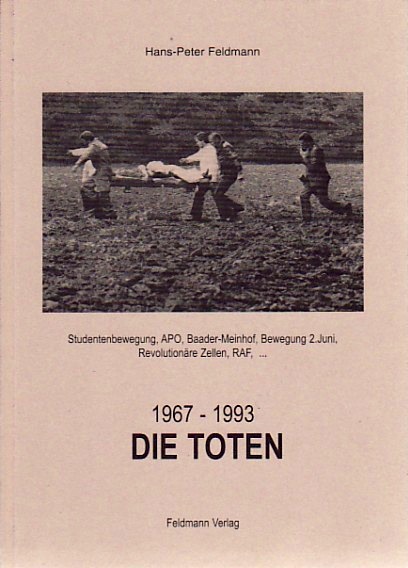


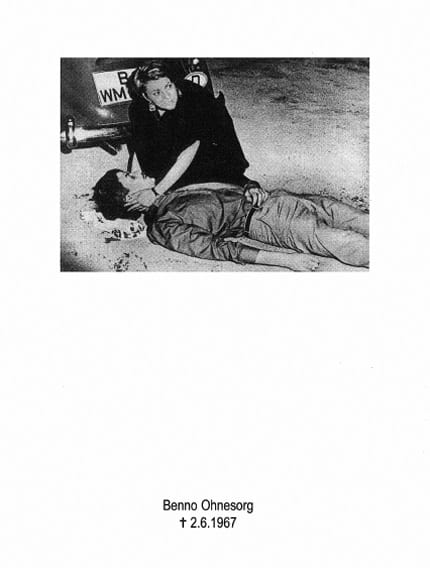
From Die Toten, 1998
Die Toten (The Dead) is a book published in 1998 that presents newspaper images Feldmann collected of 87 people who died and 3 who are “missing” as a result of the terrorist violence and state reaction between 1967 and 1993. On the cover of the book Feldmann lists the main oppositional groups involved: “Student Movement, APO, Baader Meinhof, June 2nd Movement, Revolutionary Cell, RAF…”. This subtitle is probably meant to give the browser a quick idea of what the book is about, for inside the book we see an equation of the terrorists, their victims, and the victims of state violence, each given a single page with their name and date of death preceded, obituary style, by a cross.
At the bottom of the first, otherwise blank, page is an entry from a German dictionary – “terror,oris, m:latein. – Schreck(en)” – which tells us that the word “terror” is of Latin origin and means “frighten.” After thumbing through the collection of haunting and often grisly press photos we are bound to agree that these events were and are very frightening. He has said that the purpose of the book was to “convey the size of this number of victims in graphic terms”. In email correspondence with Feldmann, he told me of his inspiration for Die Toten: “Around the end of the eighties, I happened to look in a police car which passed by and I saw two typical young policemen, mid twenties – the same age as my son at the time. It jumped into my head – ‘What could happen to these young policemen, with such a dangerous job?’ And also, ‘What could happen to my son? And I remembered in this moment the pictures of young policemen and students who were killed in the seventies.”
While we are emotionally moved by the experience of turning page after page of tragedy, Die Toten’s overall strategy is sober and factual. At the end of this hall of the dead, Feldmann includes a legend with further identification and details for each person. It was clearly important to the artist to be correct in his information and respectful of the dead, never cheapening their memory by dubious aesthetic gestures. The book informs as much as it affects.
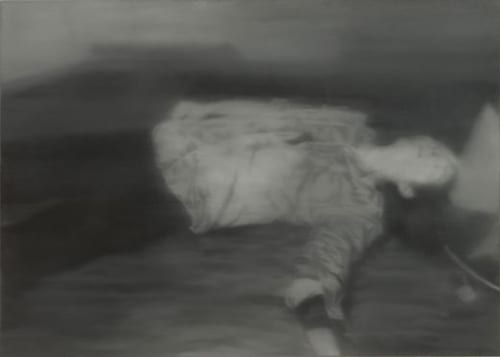
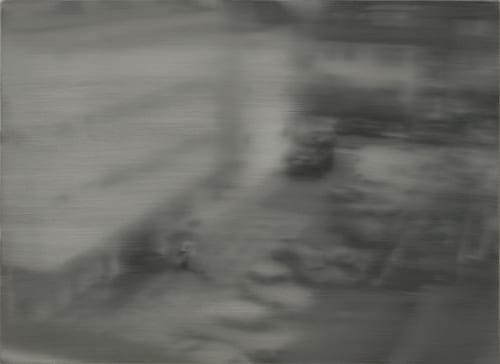
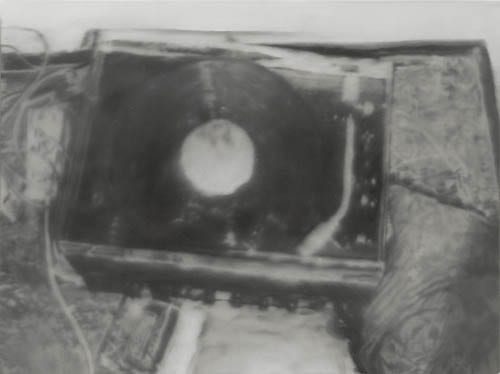
18. Oktober, 1977, Gerhard Richter
It is instructive to compare Feldmann’s Die Toten to another work which memorializes these events, Gerhard Richter’s 18. Oktober, 1977, suite of paintings depicting events around the deaths of the Baader-Meinhof Gang in Stammheim Prison. Although the prison boasted the highest security then possible, the deaths of the Baader-Meinhof involved guns which had miraculously been smuggled in. This lead to debate as to whether they had indeed committed suicide, or been murdered by the state. Richter’s paintings derive from the same kind of news clippings that Feldmann uses, but Richter translates his images into oil paintings finished with his signature “blur” technique. That Richter only chose to represent the terrorists in their “martyrdom” has drawn considerable criticism in Germany and abroad. The paintings have been seen as a partisan romanticising of those whom many see as evil murderers, or misguided young fools. Richter’s blur technique also seems to support a view that he has romanticised or mythologised his subjects, lending them a distance that can be interpreted as a sacral aura.
It was Rauschenberg who first drew attention to how photojournalism had “stolen” the job of history painting, the highest of the traditional genres, from the artists. Using the mechanical silk-screen technique, he appropriated photojournalistic images of historic importance and brought them back into the museum as paintings on canvas. Abstract painting in America has been theorized as a reaction to the cold war, a moment when artists shied away from politics and reality. When Rauschenberg fused Abstract Expressionist gesture with photographic imagery, he ended the American moratorium on the real. Warhol took things a step further by eradicating gesture and making straightforward silkscreen prints. Richter followed by taking a step back again past Warhol and Rauschenberg to the hand-painted rendition, reclaiming the beaux arts position of the painter.
While Richter’s ongoing Atlas, his scrapbook-like collection of source imagery and studies for paintings, would seem to share much with Feldmann’s encyclopaedic or archivalist sensibility, it is instead marked by telltale smears and fingerprints of paint, tape and crop marks and notations which identify the images as source material, rather than something final in themselves. It is as though Richter believes that the autonomy of the artist is inextricably bound with the materiality of paint and that to stop using paint is to risk forfeiting autonomy. Perhaps, on the other hand, Richter just believes that painting is the best medium for art. Sigmar Polke likewise retreated to the Salon and mired his painted photojournalistic history images in virtuosic, layered hallucinations.
Feldmann’s decision was to pick up where Warhol left off and get rid of paint altogether. His appropriation of the photojournalistic image is raw and direct. He felt no need to qualify his appropriations as “art” through the use of his hand or paint. His anti-auratic stance lead him to produce Die Toten as a book, unlimited in number and unsigned, as are all of his artworks. Whereas no German museum could afford the 3 million dollar price tag for Richter’s Oktober suite, leading to its purchase by New York’s MOMA, Feldmann’s Die Toten will be available to anyone with twenty dollars or a library card.
Die Toten’s strategy reaches and creates a different, larger audience and even provides a critical perspective on Richter’s Oktober paintings, but its difference is also limited. Die Toten hasn’t destroyed the Salon that Richter sustains simply by coming after, for the view from the Salon can also provide a critical perspective on the avant-gardist gesture. In one of his 1938 lectures on Aesthetics at Cambridge, Wittgenstein remarked: “I would have to explain what our photographers do today and why it is impossible to get a decent picture of your friend even if you pay £1000.” A browse through family photo albums or pictorial books will provide ample evidence of the constant steady decline in the quality of photography over the past century and more. It is no secret that the formal criteria of an “artistic” landscape or view photograph today by someone like The Bechers, Robert Adams or Andreas Gursky was fully developed by commercial and “gentlemen” photographers within a few years of the medium’s invention at the middle of the nineteenth century. It is debatable whether portrait photography has also been a victim of the rise of the compact consumer camera, or changes in social attitudes regarding the individual, but today the decline in portrait photography provides legitimate cause for nostalgia for the amateurs of early photography.
100 Jahre (100 Years) is a book Feldmann published in 2001 containing 101 photographs of friends and acquaintances ranging in age from 8 weeks to 100 years old. The 100 Years book was produced by the prestigious European art book publisher Schirmer/Mosel. While many of Feldmann’s bookworks take the ascetic, minimal forms that we associate with conceptual art, there are others that play with different book design vernaculars. The style of 100 Years is very close to the famous Schirmer/Mosel publications on the Bechers or August Sander, but it also toys with the dry rules of that style through such choices as the scrapbook arrangement of images on the cover, or the use of the ubiquitous “Comic Sans” Microsoft font. These elements keep 100 Years from looking too dry and serious about itself. It is characteristic of Feldmann to produce something ambitious and important – and then deflect from these qualities through humor. That he published 100 Years with Schirmer/Mosel is fitting – in that this project can be seen in significant relation to the work of August Sander, the Bechers, and their students, such as Thomas Struth and Thomas Ruff.
August Sander produced what is undoubtedly one of the greatest monumental projects in the history of photography. During the Weimar era, Sander documented the German people in hundreds of portraits under the title “People of the Twentieth Century”, they have become a benchmark for photographers ever since. Today, Sander’s portraits are seen as being of great historical and humanistic interest, this in spite of the fact that in retrospect the rationale for his project seems very problematic. Sander subscribed to Spenglerian ideas about social types and Civilisation’s decline that, although in no way as offensive, are as obsolete today as the ideas of the Nazis. In his attempt to make sense of the chaotic social order of a modernizing Weimar Republic, Sander fell into essentialist views. He subscribed to now ridiculous notions of natural hierarchy and believed that a person’s physiognomy was somehow tied to their social position or occupation. The idea that a portrait can tell us anything truthful or accurate about a person other than that they existed is finally always problematic. The Nazis resented Sander’s intrusion into their coveted territory as interpreters of humanity and society, forcing him to end his project and turn to landscapes.
Sander lived in Cologne, a short distance from Düsseldorf: His typological strategy and anthropological style were taken up in the ‘60s by Bernd and Hilla Becher in Düsseldorf, who catalogued aging and obsolete industrial architecture with an equally obsessive devotion. The Bechers in turn have mentored a slew of now famous students who have developed the typological study and objective gaze into æstheticised tableaux which have become a major presence in the international art market.
Feldmann’s 100 Years would appear to reach back to the beginnings of this legacy for what was most valuable in Sander’s work. Known as an artist who has championed the value of the vernacular, the family photo, the snapshot, and even the bad photo, Feldmann surprises us with 100 Years by becoming a masterful photographer. He easily meets the stringent formal criteria of Sander’s portraits: sharp, but not unnaturally sharp focus, even, diffused lighting whenever possible, contextualisation of the subject in their normal environment, and a meditative, calm, open-eyed pose where the sitter confronts the camera as though looking through the photographic apparatus at the viewer. But Sander’s rules cannot guarantee results, for the matter of personality always trumps merely technical specifications. The contradictory essence of Sander’s and now Feldmann’s mastery is egolessness on the part of the photographer – they let the camera do its job, thus causing the sitter to emerge into the picture with their full dignity intact.
With the 20/20 vision of hindsight, Feldmann has avoided trying to say anything about his subjects other than that they are human. He has understood that Sander’s portraits are astonishing and beautiful because of their mystery. In 100 Years the organizing principle of age is not something that can be deduced from the photographs themselves but must instead be supplied as a caption. Feldmann is telling us that this is how a person might look at 8 weeks or 80 years but, as with all captions, their authority is based on how much we trust their author. In the end, the photographs ignore any social differences and assert only that which cannot be argued: that we are born, we live, we die.
When I mentioned to Feldmann that I might cite Sander in relation to 100 Years, he said that I should remember that there are also many vernacular studio portraits from the same period that share the characteristics associated with a Sander portrait. This is true, and we need only think of the American studio portraitist Mike Disfarmer, the Canadian C.D. Hoy, or the recently spotlighted studio portraitists from Africa. But the monumentality, quality and ultimate value of Sander’s project towers over these comparisons. I think that Feldmann’s objection is just more of his instinctive and characteristic championing of the underdog, the vernacular, the non-obvious.
Marcel Duchamp’s protest against traditional art for being “merely retinal” and not intellectual enough, is routinely cited as the beginning of the tendency that flowered as conceptual art. By the 1960s intellectuality alone was not enough, and inspired by theorists like Marcuse, many artists saw themselves as engaging in a “revolution” against bourgeois art. “Revolution” implies a clearly drawn line between right and wrong, where the revolutionary is good and the forces of reaction are bad. Feldmann never resorts to an easy demonisation of those of whom he is critical and constantly stresses the humanity and value of the individual. He is more of a reformer than a revolutionary.
Feldmann’s self-effacing humour has meant that many have seen him as a “light” artist, when in fact his oeuvre is like a Trojan horse. It seems inviting and fun at first, but then gradually draws one into its very serious concerns, causing the viewer to think and learn from their own exploration and introspection. Compared to most art, which usually focuses on a small area of interest, the expansive, encyclopaedic nature of Feldmann’s art would seem to want to take in the whole world, yet his oeuvre feels united by his childlike and moral personality. Through his art, he has caused us to get to know him personally, and when we do, he asks: “Well, so here is the whole world, here is what people have done in the past, what does it mean to you? How will you live in this world? How will you behave towards the others who also live in it?”
BIRGIT
Jan 2006
Author: Insert with text by Roy Arden
ISBN: 0-920751-95-4
Published: Jan 01, 2006
Publisher: CAG
Price: $28.50 CDN
Released in conjunction with Hans Peter Feldmann’s first Canadian solo exhibition, Birgit is a new limited edition bookwork by Feldmann. The publication is comprised of 72 successive colour snapshots of a woman applying her make-up from beginning to end; the book is accompanied by a comprehensive text by the exhibition’s curator, Roy Arden.
ASX CHANNEL: HANS-PETER FELDMANN
(All rights reserved. Text @ Roy Arden, Images @ Hans-Peter Feldmann)
